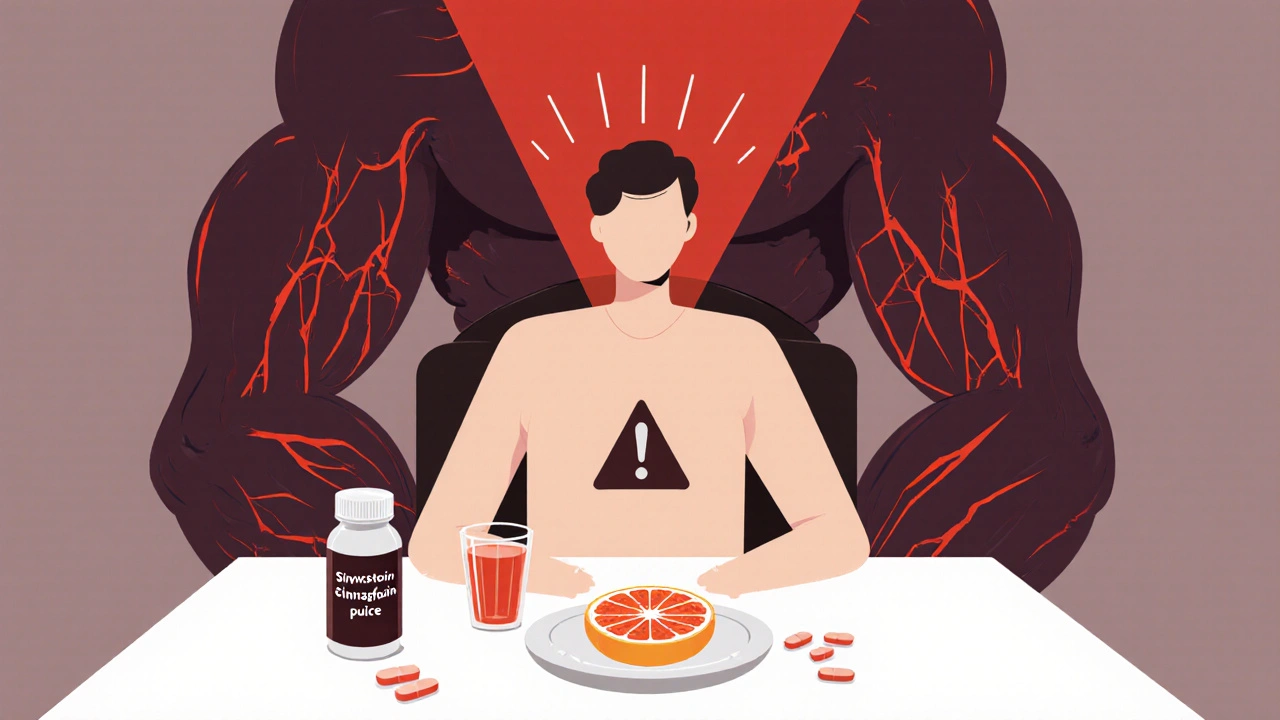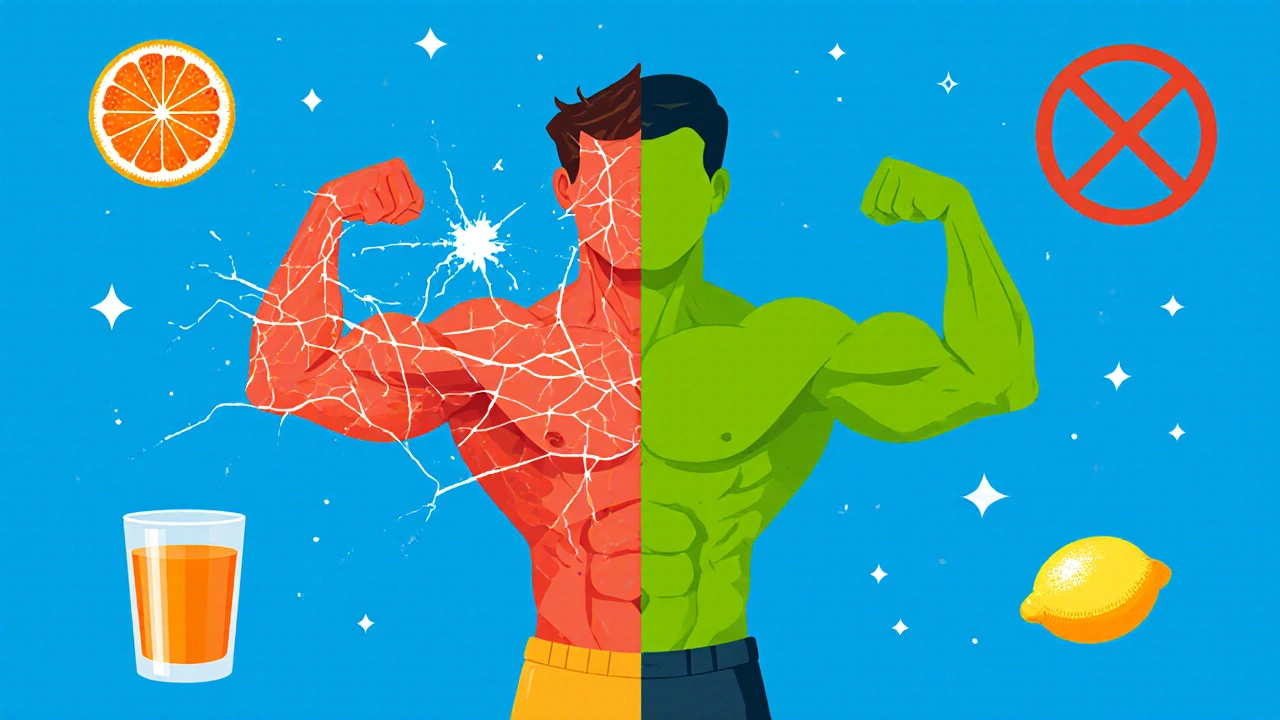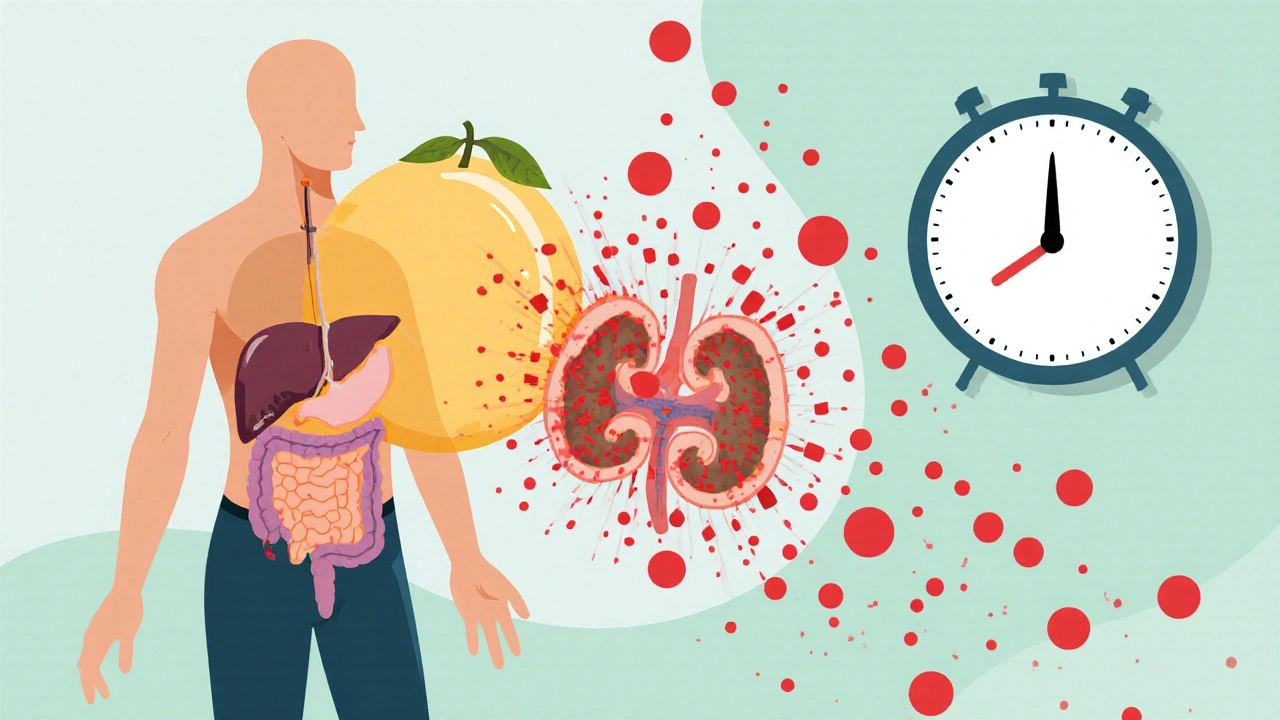Grapefruit Juice and Simvastatin: What You Need to Know About Myopathy and Toxicity Risk

Simvastatin-Grapefruit Juice Risk Calculator
Your Situation
Enter your simvastatin dose and grapefruit juice consumption to assess your risk.
Drinking a glass of grapefruit juice with your morning simvastatin might seem harmless-maybe even healthy. But if you’re on simvastatin, that habit could be putting you at risk for serious muscle damage, kidney failure, or worse. This isn’t theoretical. It’s documented, measured, and warned about by the FDA. And it’s happening to real people every year.
Why Grapefruit Juice Changes How Simvastatin Works
Simvastatin, sold under the brand name Zocor, is one of the most commonly prescribed statins in the U.S., with over 23 million prescriptions filled in 2023. It works by blocking HMG-CoA reductase, an enzyme your liver uses to make cholesterol. But here’s the catch: your body doesn’t absorb simvastatin the way it absorbs most pills. About 95% of it gets broken down in your gut before it even enters your bloodstream-thanks to an enzyme called CYP3A4. Grapefruit juice doesn’t just taste tart. It contains chemicals called furanocoumarins-mainly bergamottin and 6’,7’-dihydroxybergamottin-that permanently disable CYP3A4 enzymes in your small intestine. Once those enzymes are shut down, simvastatin isn’t broken down. It floods into your bloodstream. Studies show that drinking just 200 mL of grapefruit juice three times a day can increase simvastatin levels in your blood by up to 16 times. That’s not a small bump. That’s a dangerous spike.What Happens When Simvastatin Levels Go Too High
Too much simvastatin in your system doesn’t mean better cholesterol control. It means more side effects-and the most dangerous one is myopathy. That’s muscle pain, weakness, or damage. In severe cases, it turns into rhabdomyolysis, where muscle cells break down and spill their contents into your blood. Those toxins can clog your kidneys, leading to acute kidney failure. About 0.1% of statin users develop rhabdomyolysis on their own. But when grapefruit juice is added, that risk jumps significantly. The FDA’s 2023 update warns that this interaction can lead to liver damage, kidney failure, and even death. Symptoms to watch for: unexplained muscle pain or tenderness, especially in your shoulders, thighs, or lower back; dark urine; extreme fatigue; or feeling weak for no reason. If you’re taking simvastatin and notice any of these, stop the juice and call your doctor immediately.How Much Grapefruit Juice Is Too Much?
The good news? Not every sip is dangerous. The FDA says the real red flag is consuming more than 1.2 liters (about five 8-ounce glasses) of grapefruit juice per day. That’s the threshold where CYP3A4 inhibition becomes clinically significant-around 47% suppression. One glass? Probably fine for most people. But if you’re sipping grapefruit juice with every meal, or drinking it as your morning detox drink, you’re in the danger zone. A 2022 Mayo Clinic survey found that 63% of statin users thought even a small amount of grapefruit juice was unsafe. Meanwhile, 28% were drinking more than the 1.2-liter limit and didn’t realize it. The confusion is real. So here’s the simple rule: avoid more than five 8-ounce glasses daily. If you’re on a higher dose of simvastatin (40 mg or 80 mg), even one glass a day may be too much.
Not All Statins Are the Same
This interaction isn’t true for every cholesterol drug. Simvastatin and lovastatin are the worst offenders because they rely almost entirely on CYP3A4 to break down. Atorvastatin (Lipitor) has a moderate interaction-up to a 3.3-fold increase in blood levels. But pravastatin (Pravachol) and rosuvastatin (Crestor)? They’re not metabolized by CYP3A4 at all. That’s why the FDA only lists simvastatin and atorvastatin in its grapefruit warnings. If you regularly drink grapefruit juice and are on simvastatin, talk to your doctor about switching. Pravastatin or rosuvastatin are safer alternatives with similar effectiveness. In fact, the American College of Cardiology recommends switching statins for patients who consume grapefruit products regularly-especially if they’re over 65, have kidney problems, or are taking other medications like amiodarone or calcium channel blockers that also interact with CYP3A4.How Long Does the Effect Last?
You might think skipping grapefruit juice for a day is enough. It’s not. The furanocoumarins in grapefruit juice don’t just pause the enzyme-they destroy it. Your body has to make new CYP3A4 enzymes to replace them. That takes 3 to 7 days. So if you drank a large glass on Monday, you’re still at risk on Wednesday, even if you didn’t touch grapefruit juice in between. That’s why timing doesn’t fix the problem. Waiting 4 hours between your juice and your pill? Doesn’t help. The enzyme inhibition is long-lasting. The only reliable way to avoid the interaction is to cut out grapefruit juice entirely-or switch to a different statin.What About Other Citrus Fruits?
Not all citrus is dangerous. Seville oranges (used in marmalade) and pomelos also contain furanocoumarins and should be avoided. But regular orange juice? Safe. Tangerines? Safe. Limes and lemons? Also safe. The problem isn’t citrus-it’s specifically grapefruit and its close relatives. Some people think they can just eat the fruit instead of drinking the juice. That’s not safer. The same compounds are in the pulp and peel. A whole grapefruit has just as much furanocoumarin as a glass of juice. If you’re on simvastatin, skip the fruit too.
What Experts Really Say
There’s some disagreement among doctors. The American Heart Association says that drinking one glass of grapefruit juice daily only increases simvastatin levels by 30-40%-not enough to cause harm in most people. Dr. Stanley Hazen from Cleveland Clinic says if you’ve been on simvastatin for years without side effects, you can probably enjoy half a grapefruit or one glass of juice. But the FDA’s Dr. David Graham says something different: we can’t predict who will have a bad reaction. One person might drink a quart daily and feel fine. Another might have muscle damage after one glass. That unpredictability is why many doctors recommend complete avoidance. The safest approach? Assume you’re the one who will react badly. Especially if you’re older, have kidney issues, or take other meds. Don’t gamble with your muscles.What Should You Do?
Here’s a clear action plan:- If you’re on simvastatin: Avoid grapefruit juice and grapefruit entirely. No exceptions.
- If you’re on atorvastatin: Limit grapefruit to less than one glass per day, and avoid it if you’re on a high dose (80 mg).
- If you love grapefruit: Ask your doctor about switching to pravastatin or rosuvastatin. Both are just as effective for lowering cholesterol and don’t interact with grapefruit.
- If you’re unsure: Check your prescription bottle. The FDA requires grapefruit interaction warnings on simvastatin labels since 2014. If it’s there, take it seriously.
- If you’ve already had muscle pain: Stop the juice and call your doctor. Get a blood test for creatine kinase (CK) levels. High CK means muscle damage.
The Bigger Picture
This isn’t just about one fruit and one drug. It’s about how food and medicine interact in ways most people don’t understand. Over 39 million Americans take statins. Grapefruit is one of the top 10 consumed citrus fruits in the U.S., with 14.5 million cases produced annually. The risk is real, widespread, and preventable. Researchers are working on solutions. The University of Florida has developed a new grapefruit hybrid called UF Sweetie that has 87% less furanocoumarin. It’s not on shelves yet, but it’s a sign that science is catching up. For now, though, the answer is simple: if you’re taking simvastatin, skip the grapefruit. Your muscles-and your kidneys-will thank you.Can I drink grapefruit juice if I take simvastatin once a day?
No. Even one glass of grapefruit juice can significantly increase simvastatin levels in your blood. The interaction isn’t about timing-it’s about enzyme damage that lasts for days. The safest choice is to avoid grapefruit juice completely while on simvastatin.
Is it safe to eat grapefruit instead of drinking the juice?
No. The same furanocoumarins that block CYP3A4 are present in the pulp and peel of the fruit. Eating half a grapefruit has the same risk as drinking a full glass of juice. Avoid the whole fruit if you’re on simvastatin.
What if I only drink grapefruit juice once a week?
Even occasional consumption can be risky. CYP3A4 enzymes take 3 to 7 days to regenerate. If you drink grapefruit juice on Monday, you’re still at risk on Thursday. Consistent use-even once a week-can keep enzyme inhibition active. It’s safer to eliminate it entirely.
Are there other juices that interact with simvastatin?
Yes. Seville oranges (bitter oranges) and pomelos also contain furanocoumarins and should be avoided. Regular orange juice, tangerines, lemons, and limes are safe. Always check the type of citrus-only grapefruit and its close relatives are dangerous with simvastatin.
What are the signs I should stop simvastatin and call my doctor?
Call your doctor immediately if you experience unexplained muscle pain or weakness, especially in your back or thighs; dark or tea-colored urine; extreme fatigue; or reduced urination. These could be signs of rhabdomyolysis, a life-threatening condition caused by muscle breakdown. Don’t wait-get checked right away.
Can I switch to a different statin to avoid grapefruit interactions?
Yes. Pravastatin and rosuvastatin are not broken down by CYP3A4, so they don’t interact with grapefruit juice. If you enjoy grapefruit, talk to your doctor about switching. These alternatives are just as effective for lowering cholesterol and carry no grapefruit-related risk.
Does the FDA still warn about this interaction?
Yes. The FDA updated its guidance in 2023 and still lists simvastatin as a drug with a clinically significant interaction with grapefruit juice. The warning appears on all simvastatin packaging and is reinforced in consumer safety alerts. This is not an outdated concern-it’s current and active.

Jefriady Dahri
November 23, 2025 AT 05:00Yo, this is wild but so important 😮💨 I’ve seen so many people just sip grapefruit juice like it’s water and never think twice. My uncle was on simvastatin and drank it daily-ended up in the hospital with rhabdo. Docs said it was lucky he didn’t lose a kidney. Please, if you’re on this med, just swap it out. Rosuvastatin’s just as good and doesn’t play games with your muscles.
Archana Jha
November 24, 2025 AT 07:15they say grapefruit is dangerous but what if the real danger is the pharmaceutical companies pushing statins to begin with?? i mean… why do we even need to lower cholesterol so aggressively?? it’s not like our bodies didn’t evolve with it… maybe the juice is just nature’s way of saying STOP taking synthetic junk?? 🤔
Aki Jones
November 24, 2025 AT 18:17Let me just say this: the FDA doesn’t care about you. They’re paid off by Big Pharma. The 16x spike? That’s a fabricated scare tactic to push you toward pravastatin-which, by the way, is manufactured by the same company that makes simvastatin. They just want you to keep buying. And don’t even get me started on the ‘3-7 day enzyme recovery’ myth-that’s not even biologically plausible. CYP3A4 doesn’t work like that. This is all corporate propaganda wrapped in a lab coat.
Patricia McElhinney
November 24, 2025 AT 19:02It is imperative that individuals who are currently undergoing pharmacological management with simvastatin adhere strictly to contraindications delineated by regulatory authorities. The pharmacokinetic interaction between furanocoumarins and CYP3A4 is not merely anecdotal-it is quantitatively validated via randomized controlled trials, with p-values < 0.001. Disregarding this is not merely irresponsible-it is medically negligent.
Amy Hutchinson
November 26, 2025 AT 14:33Wait so if I eat a grapefruit at breakfast and take my pill at night… is that okay?? I just wanna know before I panic 😅
Andrew McAfee
November 28, 2025 AT 01:29Back in Nigeria we drink orange juice with everything and no one’s dropping dead. I think this whole thing is overblown. Maybe it’s a Western problem because people eat too much processed food and then blame a fruit. I’ve known three people on statins who drank grapefruit juice daily. All fine. Maybe your body just adapts
Andrew Camacho
November 28, 2025 AT 14:37OH MY GOD I JUST REALIZED I’VE BEEN DRINKING GRAPEFRUIT JUICE WITH MY SIMVASTATIN FOR 4 YEARS 😭 I’M GOING TO DIE. I’M GONNA HAVE A HEART ATTACK AND THEN MY MUSCLES WILL MELT AND MY KIDNEYS WILL JUST… QUIT. I CAN’T BELIEVE I WAS THIS STUPID. I’M SORRY MOM. I’M SORRY EVERYONE. I’M SORRY I EVER TRUSTED THE FDA.
Sharley Agarwal
November 30, 2025 AT 02:07Don’t be naive. If you’re not taking it seriously, you’re already dead inside.
prasad gaude
December 1, 2025 AT 17:35You know… in India we have this saying: ‘The fruit doesn’t lie, but the pill doesn’t tell the whole truth.’ Maybe the body knows what it needs. I’ve seen grandmas on statins, sipping grapefruit juice, dancing at weddings. Maybe the real issue isn’t the juice… it’s how we’ve forgotten how to listen to our bodies.
Srikanth BH
December 2, 2025 AT 15:38Hey, don’t stress! You’re not alone. I was in the same boat-simvastatin + grapefruit juice daily. I talked to my doc, switched to rosuvastatin, and now I enjoy my juice without guilt. It’s not a sacrifice-it’s a upgrade. Your muscles will thank you. Seriously, just do it. You got this 💪
Jennifer Griffith
December 4, 2025 AT 07:46wait so grapefruit juice is bad but i can drink orange juice?? so what’s the diff?? like… are they lying to us?? i feel so confused now 😩
Dolapo Eniola
December 5, 2025 AT 01:32USA thinks it’s the center of the world. In Nigeria, people drink anything with anything and live to 90. You people overmedicate and then blame fruit. My cousin took simvastatin, drank grapefruit juice, ran marathons. He’s fine. Stop being scared. You’re not a lab rat.
Erika Hunt
December 5, 2025 AT 13:23I’ve been thinking about this a lot… and honestly, I’m torn. On one hand, the science is clear-CYP3A4 inhibition is well-documented, and the FDA’s warning is based on real case reports. On the other hand, I know people who’ve consumed grapefruit juice daily for decades on simvastatin and never had an issue. Maybe it’s genetic? Maybe some people metabolize it differently? I think the blanket ‘avoid entirely’ advice is too rigid. What if we personalized it? What if we tested CYP3A4 activity before making recommendations? I just feel like we’re missing nuance here… and that’s dangerous too.
Pallab Dasgupta
December 7, 2025 AT 13:01Bro I just switched to rosuvastatin after reading this. And guess what? I’m still drinking my grapefruit juice. No muscle pain. No dark pee. No drama. Just me, my juice, and my peace of mind. If you’re scared, talk to your doctor. Don’t just panic on Reddit. You’re not alone. And you’re not doomed. 🙌